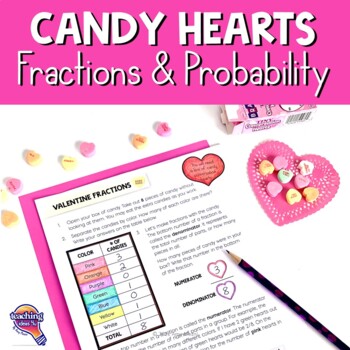Fractions & Probability Valentine's Day Candy Heart Activities
- PDF
Description
Conversation Heart Fractions & Probability Valentine's Day Activities
Are you looking for fun lessons for Valentine's Day that are still Standards related? Check out these fun math activities using Valentine's Day candy hearts:
- Candy Heart Fractions - Three different fraction lessons are included, so teachers can use it with grades 3, 4, or 5. The lessons could also be used for differentiation.
- Candy Probability - Students use conversation hearts in an introductory lesson on probability.
Do You Want More Valentine's Lessons?
The Fractions & Probability lessons can be purchased in a Valentine's Day Thematic Bundle with a science experiment and other activities. The science experiment is also available separately.
For reading, try these Valentine's Day Paired Passages. Set includes 2 sets of 2 passages: one on chocolate and the other on Valentine's Day. Each passage is included on two reading levels. Reading comprehension quizzes and writing prompts are included.
*********************************************************************
Customer Tips:
How to get TPT credit to use on future purchases:
• Please go to your My Purchases page (you may need to login). Beside each purchase you'll see a Provide Feedback button. Simply click it and you will be taken to a page where you can give a quick rating and leave a short comment for the product. Each time you give feedback, TPT gives you feedback credits that you use to lower the cost of your future purchases. I value your feedback greatly as it helps me determine which products are most valuable for your classroom so I can create more for you. ☺
Be the first to know about my new discounts, freebies and product launches:
• Look for the green star next to my store logo and click it to become a follower. Voila! You will now receive email updates about this store. ☺
*********************************************************************





